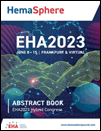P1223: IMAGING MASS CYTOMETRY REVEALS A HIGHLY HETEROGENOUS CELL MAKEUP AND SPATIAL CONTEXT OF THE FOLLICULAR LYMPHOMA TUMOR MICROENVIRONMENT
Abstract Topic: 20. Lymphoma Biology & Translational Research
Background: The highly variable clinical course and response to treatment of follicular lymphoma (FL) is strongly influenced by the tumor microenvironment (TME). While both pro- and anti-tumor effects depend on cell-cell interactions within the TME, these mechanisms remain incompletely understood. Additionally, single cell studies focused on illuminating the TME often lack spatial context, while conventional immunohistochemistry investigations are limited by a low number of parameters. Imaging mass cytometry (IMC) allows multiplexed analysis of up to 40 markers in tissue simultaneously, offering a unique opportunity to study the spatial context of single cells and the neighborhoods they reside in within the TME, informing both disease biology and predictors of clinical outcome.
Aims: To characterize the cell makeup and spatial context of the FL TME by IMC, we used fixed formalin paraffin embedded (FFPE) biopsies from untreated FL patients, enrolled on the Gallium trial (NCT01332968) of frontline chemo-immunotherapy, resulting in 381 high-dimensional images for analysis.
Methods: IMC has more commonly been applied to solid malignancies such as lung or breast cancer tissues. FL presents unique challenges in this remit, such as its morphologic variability and phenotyping cells within highly structured, dense lymph-node tissue composed of inherent tight-knit lymph node zones (including follicular and non-follicular areas) made up of different cells and neighborhoods. To analyse FL tissue by IMC, we first optimized a 31-plex panel to identify key immune and non-immune lineages including tumor cells, T and NK cells, macrophages, fibroblasts, dendritic, endothelial and reticular cells. In addition, we wished to identify functional substates such as memory, effector or regulatory phenotypes in addition to other parameters including activation, exhaustion and proliferation. Following image pre-processing, quality control exclusion of 13 images and deep-learning based cell segmentation, we performed single-cell analysis of more than 3 million cells across 368 high-dimensional images.
Results: Adopting a multi-step unsupervised clustering regime, we identified follicular and non-follicular localized tumor populations with variable proliferative status. In addition, we have identified tumor-proximal and -non-proximal immune cell clusters of single cells including CD4+ T cells, macrophages and CD8+ T cells. Interestingly, we observed substantial heterogeneity regarding the presence of different cell phenotypes across samples. In particular, by analysing the proportions of identified macrophage vs. T cell populations, we found considerable variation between samples of follicular lymphoma tissue.
Summary/Conclusion: We report the use of IMC to explore the TME of untreated FL and have observed marked heterogeneity of identified cell phenotypes and their neighborhoods across FL. Interestingly, we have found variation in macrophage vs. T cell quantities across samples, consistent with published literature demonstrating how these lineages give different dominant signatures in different patients. Ongoing work seeks to examine associations between features identified in our analyses with clinical outcomes and other disease parameters, in order to provide a detailed characterization of how the spatial context of FL TME influences disease behavior, response to treatment and survival. Keywords: Follicular lymphoma, Microenvironment, Cytometry




